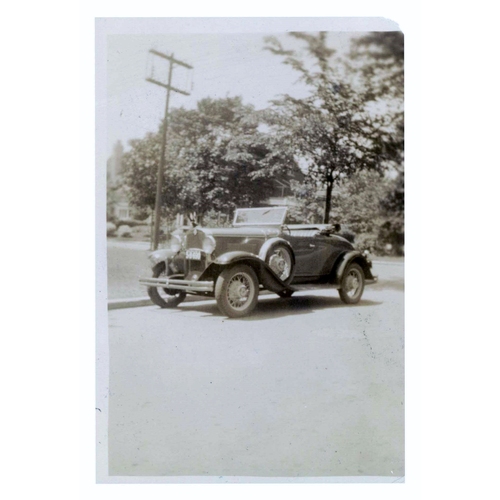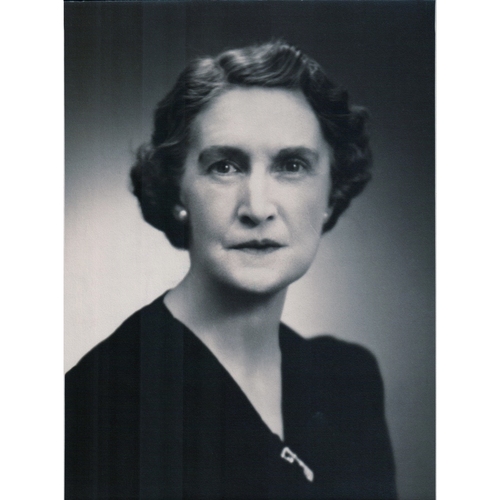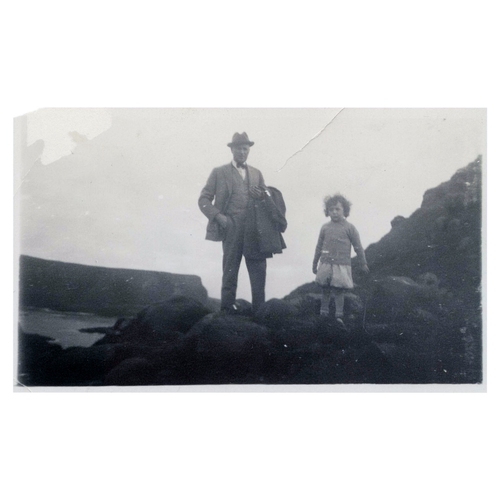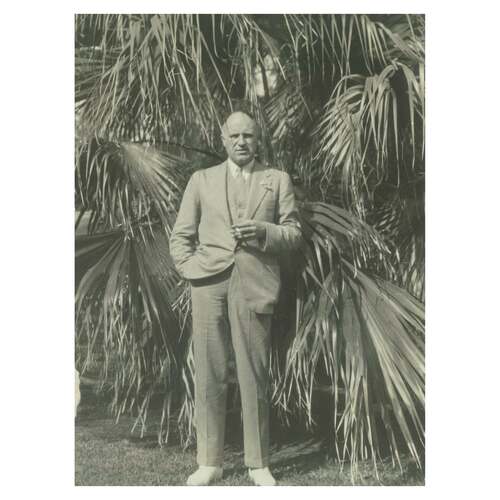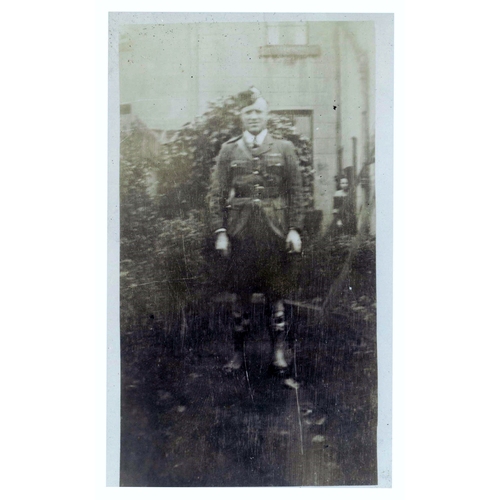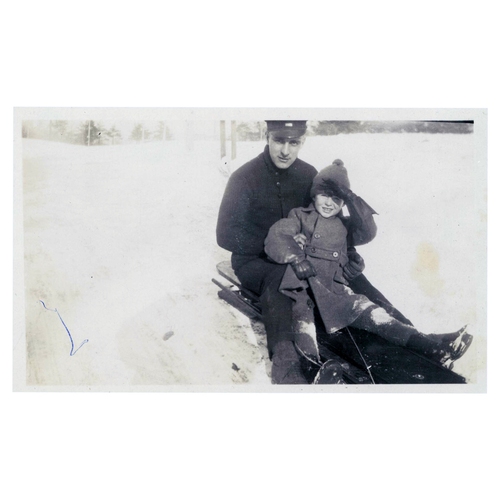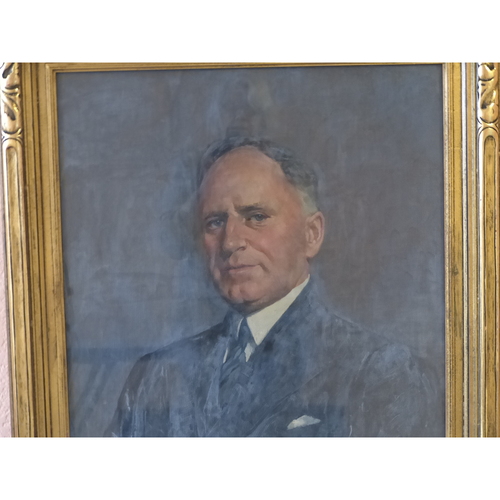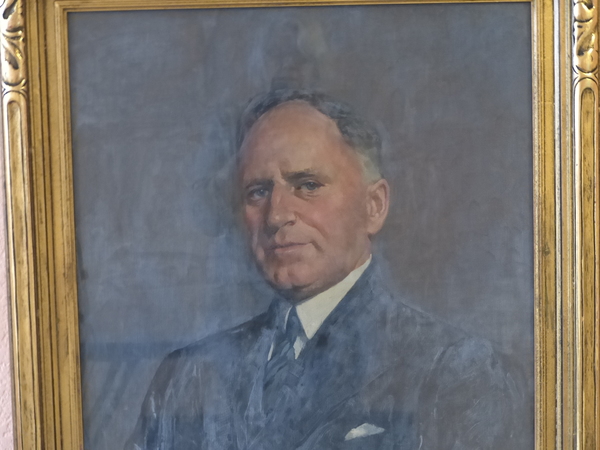
Source: Link
PENTLAND, WILLIAM JAMES, businessman and sports entrepreneur; b. 31 March 1888 in Gilford, County Down (Northern Ireland), son of Valentine Pentland and Mary Anne Davidson; m. 30 May 1912 Edith U-Raynor Smith in Old Orchard Beach, Maine, and they had a son; d. 25 Feb. 1933 in Toronto.
One of five siblings, William J. Pentland was raised on his family’s farm and in Scotland, where for a time in the 1890s his father worked as a labourer in Govan (Glasgow). Following the Pentlands’ return to Ulster, young Bill was educated at elementary schools in Holywood and nearby Belfast. As a youth he found employment with a grocer in Holywood and served an apprenticeship with the Belfast Ropework Company. In 1908 he became office superintendent of the Ross Linen Weaving Company in Kells, but by 1911 the family, all members of the Church of Ireland, were again living in Belfast. Whatever Pentland’s views on Irish independence, he would hold them close, and only fragmentary evidence remains. In 1912 his father signed the Ulster Covenant opposing Home Rule for the island, but a friend of William’s would subsequently claim that as teenagers the two boys ran “errands” for a republican body. The Nationalist presence in County Down provides scant context for this problematic assertion.
Seeking fresh opportunities, William and his brothers Samuel Brown and Robert L. immigrated to the United States in 1911, and all three found employment with the country’s dominant grocery chain, the Great Atlantic and Pacific Tea Company, known as A&P. They took up residence in Old Orchard Beach, where Bill met and married Edith, a daughter of farmer Thomas Smith from Skipton, England. Together the happy band also ran a boarding house, an existence that Edith would later fondly recall. With the outbreak of World War I, however, Robert returned to Britain to enlist; he died in France in 1917.
Bill had quickly grasped the elements of A&P’s low-price system, which was revolutionizing the trade. In 1912 the company introduced the economy-store format, which focused on a more limited, set assortment of goods sold on a cash-and-carry basis. This approach eliminated the depletion of capital that credit, home delivery, and premiums caused. The chain grew phenomenally, from some 350 stores in 1910 to more than 4,620 a decade later. At the age of 28 Pentland became a general superintendent in its New England division, evidently responsible for Connecticut.
Grocery retailing eventually brought him to Toronto, on a path that began in the border state of New Hampshire. During a golf game Robert Jackson, a Concord lawyer and commercial risk-taker, learned from a Canadian that there was potential for food chains in central Canada along the lines of A&P and the stores newly opened there by Theodore Pringle Loblaw. With help from investment bankers Robert W. and John Butler Jameson, also from Concord, and other American capitalists, Jackson had Dominion Stores Limited incorporated in Canada in May 1919, just two months after A&P had taken a similar step. Jackson was president of the new enterprise, Pentland vice-president, and R. W. Jameson treasurer.
How co-founders Jackson and Pentland had originally met is uncertain, nor is much known about Pentland’s departure from A&P. According to the trade journal Canadian Grocer, he was vacationing in Old Orchard Beach when he received a telephone call asking him to manage the new chain; though his wife was pregnant, he, with typical decisiveness, set off immediately. There must have been some prior understanding, however. One source notes that he may have left his former employer in 1918 to lay the groundwork for Dominion. In April the following year, as the costs of living in post-war Ontario were rising, he arrived in Toronto, whose northern Irish population once had gained it the epithet “the Belfast of Canada.”
Dominion’s first stores, on Wallace Avenue in a working-class area to the west and on Queen Street in the east end, were small operations based on the A&P model: long, narrow shops in existing, leased retail premises. Service remained traditional, with staff filling orders from behind counters, shelves along the walls, and stacks of dry and canned products in the centre. Prices were cut-rate, increasingly so through volume purchasing and the elimination of middlemen. Corporate stories recall Jackson, aproned and happily handling groceries, at Wallace Avenue in the early years. Pentland excelled at scouting out new locations on streetcar and automobile routes, in suburban areas, and often aggressively close to independent shopkeepers. His job expanded in August 1919 when Loblaw, who had become manager of the United Farmers’ Co-operative Company, and his partners agreed to sell their outlets to Dominion. On 25 October Pentland took over responsibility for some 16 stores, all in Toronto, though the sale would not be completed until the following February.
Undeterred by Loblaw’s return to the grocery business with self-serve outlets, Pentland, as vice-president in charge of field operations, opened a store a week, on average, during the 1920s. Each location earned him a bonus of $3 per week, so that by the middle of the decade he was making nearly $60,000 annually in addition to his basic salary of $15,000. Dominion’s growth peaked in 1931 with 572 units in Ontario, Quebec, and the Maritimes. Controlled pricing that was lower than that in Loblaw’s stores and increased patronage on the part of both the working and the middle classes were achieved through efficiencies and a wider range of merchandise. In October 1920 Dominion had still been promoting post-war economies for buyers. Its 38 Toronto stores, for instance, were among the large number of city shops selling Swift’s and Gem Nut brands of margarine, the oil-based spread on which a national ban had been lifted in 1917 as a result of dairy shortages. In 1921 Dominion’s image began to change. Newspaper advertising intensified, and storefronts were standardized through the installation of awnings emblazoned with the slogan “Where Quality Counts.” A year later house-brand products such as baking powder and cocoa were introduced; by 1928 fruit and cooked meats had been added. Rebates and discounts were negotiated with leading manufacturers. A new warehouse and office headquarters were acquired in Toronto in 1924 and a warehouse in Montreal the following year; three baking plants were also added. Pentland was interested in improving conditions for his employees: he introduced group insurance for them in 1922, and sports teams were organized. To promote cohesiveness and bonhomie within the chain, the Link (Toronto), a convivial little journal filled with news items, gossip, and tips on selling, was launched in 1924. For the issue the following January, “our Economy Month,” Pentland wrote an article on ways that store managers could reduce expenses.
He was described by contemporaries as a “prodigious worker” and a “human dynamo,” who was constantly on the road between cities and stores. When Dominion had been expanding into Quebec, he maintained an apartment in Montreal and spent half his week there. Photographs suggest a serious demeanour, showing deep-set blue eyes beneath a high forehead, but despite his apparently aloof manner, Pentland’s family and associates knew him to be generous. Soon after coming to Toronto, he arranged for his parents to join his family on High Park Boulevard. His father died in 1921 and was buried in Toronto; his mother would pass away in a Belfast nursing home eight years later. Pentland also brought over from Ireland a sister who had been abandoned by her husband, together with her children, and gave them a house.
Keenly interested in sports, Pentland “often wanted to tramp the golf links, but had not time.” He followed the Toronto Maple Leafs hockey team but made his most passionate commitment to football (soccer), which he had played in his youth. In Toronto he became affiliated with the ten-year-old Ulster United Football Club in 1923 and served as its president the following year. In May 1925 he helped to form Ulster Stadium Limited, which built a large facility for the team near Greenwood Avenue and Gerrard Street in the city’s east end. The 1920s and 1930s were golden years for soccer in Canada. Crowds well in excess of 5,000 flocked to the sports ground, and it soon acquired a sewer hook-up. Pentland also had floodlights installed for night-time games. Behind the scenes he was vice-president of W. A. Moffatt and Sons, one of the stadium’s principal builders. A tavern called the Ulster Arms Hotel sprang up nearby. Competing in various leagues with mostly British-born players, Ulster United won its first national championship in Winnipeg in 1925.
With Dominion Stores doing well, the Pentlands moved to the prestigious suburb of Forest Hill in about 1928, into a house at 262 Warren Road. The next year they sent their son, William Thomas, to St Andrew’s College in Aurora, north of the city. Not surprisingly, Pentland, always on the go, was enthusiastic about fine, fast automobiles, and he had many over the years. During a visit to Ireland he bought a Humber convertible for touring. Later he owned a powerful 12-cylinder Cadillac, a Chevrolet sports coupe, and a mahogany motorboat, which he used at the family’s summer home on Lake Simcoe near Beaverton. Winter vacations were often spent in Bermuda, on one occasion with Pentland’s brother Sam and his family. A freemason (Ulster Lodge No.537), Shriner, Rotarian, sometime militiaman, and an Anglican by upbringing, Bill had joined the United Church of Canada by 1933, as a member of the Timothy Eaton Memorial congregation. In politics he was a Conservative and professed a “firm” if nebulous social belief in “co-operation and man-development.” He stopped short of adopting the fervent Oxford Group creed that Loblaw tried to press upon him. “W. J.” found time for speaking engagements at retailers’ conventions and local club meetings. His memberships included the exclusive Seigniory Club at Montebello, Que., though his involvement there was slight.
In the rapidly changing retail sector, Pentland’s drive to build up Dominion Stores impressed his peers and the company’s shareholders. He communicated business matters well and climbed within the corporate structure: having been made vice-president in charge of field operations in 1925, he became chairman of the board four years later, and president in 1930. Canadians were adapting to the introduction of chains, including Charles Allen Gordon Tamblyn’s drugstores and the variety stores of the American-owned F. W. Woolworth and S. S. Kresge companies. Within the urban grocery field, A&P, despite its early incorporation in Canada, entered Montreal only in 1927 and Toronto a year later. The veteran department store founded by Timothy Eaton*, which had been handling groceries for decades, launched self-serve food outlets in 1927, but this venture proved unsuccessful. Though Dominion Stores had vastly more stores than Loblaw Groceterias, the latter boasted greater sales per unit and higher profits. At the same time, competition forced independent grocers at both the wholesale and the retail levels to make structural changes in the decade after World War I. These included, most notably, the formation of cooperatives and buying pools, such as the York Trading Company, Adanac Stores, Leader Stores, and the National Grocers Company, all based in Toronto. Expansion of outlets to the point of excess capacity was also undermining the grocery chains.
The challenge to independent owners produced an anti-chain movement, beginning in 1927 in the United States, where A&P was a prime target. This fight spread into Canada and was intensified by the Great Depression. The basic legislative strategy was discriminatory taxation on the chain stores, but tax bills had limited success. Attempts stalled in Ontario in 1932, though proponents did secure an essential legal definition of a “chain store” the following year. Efforts in Quebec halted in 1933. In Toronto, where Pentland’s vital interests lay, some aldermen had marshalled petitions and expressions of concern from other Ontario municipalities in a bid to pressure the province for legislation. But chains were not monopolies, Pentland told a meeting of the city’s civic legislation committee in December 1931. Alderman William John Wadsworth, he remarked, “must be awfully dumb if he can’t understand.”
Far more problematic was the biting impact of the depression. The worst years would prove to be 1932–33. Pentland saw the effect on customers: some were unemployed; most had reduced incomes. Pentland himself was a modest contributor to the Federation for Community Service. A plan to merge the Loblaw operation with Dominion, carefully orchestrated by Merrill, Lynch, and Company of New York, had been terminated after the stock market crashed in October 1929, a cataclysmic event that also forced Robert Jackson into personal bankruptcy and out of Dominion’s presidency. Profits declined, and Dominion’s share prices tumbled from a high of 55 points in 1929 to a low of 13⅜ three years later. Investors were warned off by analysts. The “chain stores are having a bad headache keeping above the water these days,” one commented in December 1932. Markdowns (loss-leaders) had been taken to their limit the previous year, and with price advantages over neighbouring independents dropping, some desperate Dominion store managers resorted to selling goods at short weight. Consumers were equally hard-pressed, and a lawsuit against the company in November 1932 over an insect found in a can of pork and beans exacerbated public worries.
Apparently undeterred, Dominion had bought a small Ottawa chain in December 1929 and 12 Canadian Stop and Shop outlets two years later. It began to mark up prices as operating expenses increased. Within the company Pentland continued to be held in esteem: in September 1931 the headquarters and supervisory staff presented him with his portrait, painted by society artist Edmund Wyly Grier*. That year Pentland raised a loan in New York to pay dividends, but his optimism was eroding. Through 1932 and into the following year wages were cut and unprofitable stores closed. At the company’s annual meeting on 23 Feb. 1933 Pentland told shareholders that the days of trying to prophesy “when normal times will return are past.” Privately, and with money owing on his club bills, he had lent “substantial sums” to the Moffatt firm, which had helped to construct Ulster Stadium.
Loblaw, who saw Pentland for the last time at a wedding reception on the evening of 24 February, witnessed a troubled man. “His brain had been much overwrought lately,” Loblaw would later remark. Just after 3:00 a.m. the following morning, as Pentland was driving home alone, his Cadillac crashed into a concrete safety pillar on St Clair Avenue, killing him instantly. The coroner believed that he had suffered a stroke. Pentland’s death at age 45, Canadian Grocer lamented, was a “great shock to a host of friends” in the trade. Within the soccer fraternity, the passing of the “godfather of Ulster Stadium,” as the Evening Telegram’s William Fenton* called him, was equally mourned.
The presidency of Dominion Stores was assumed by Morley Smith, a lawyer who had been involved in the company’s incorporation and stayed on in management. But with both Jackson and Pentland abruptly removed and sales at all grocery chains wilting under the impact of the depression, Dominion endured several sluggish years. Moreover, it was not immune to problems in the American market. In March 1934, 71 per cent of the company’s shares were American owned, even though the largest single stockholder was its major meat supplier, Canada Packers Limited, founded by James Stanley McLean*. Edith Pentland’s inheritance of more than $331,500 included no interests in Dominion. She continued to live on Warren Road until 1943, when, after ten difficult years, she committed suicide. Memories of W. J. Pentland were revived briefly at the company’s 60th anniversary celebration, but his name had largely disappeared from public consciousness by 2005, when Dominion was taken over by the Metro chain of Quebec. The new owners would eliminate the Dominion brand three years later.
The author is grateful to Sean Carrie, Colin Jose, Judy Love-Eastham, and Stephen A. Otto for their sharing of information. A Pentland genealogy and other records were provided by Colin Pentland D. Yarwood of North Cambridgeshire, Eng. Additional family data were gathered by Jesse C. Roberts from ancestrylibrary.com. Sir Edmund Wyly Grier’s portrait of William James Pentland, a photograph album, and the memoirs of his son are in the possession of a granddaughter, Stephanie Pentland Evans of Toronto. In the corporate realm, a fire at Dominion’s offices in 1924 destroyed its earliest records. Seven issues of the Link published between 15 June 1924 and 15 Oct. 1925 are preserved at the TRL. Other information on Pentland’s era may be found in Can., Royal commission on price spreads, Minutes of proceedings and evidence … (Ottawa, 1935). A clipping of an interview of Theodore Pringle Loblaw by Strathearn Boyd Thomson published in Hush (Toronto) between 25 Feb. and 2 April 1933 is held at the George Weston Limited Corporate Arch. (Toronto).
A rare film of a soccer match at Ulster Stadium in 1930 between Ulster United and the touring Glasgow Rangers, titled With the Glasgow Rangers in Ontario, is held by LAC in the Graphic Consultants Coll. (R9198-0-1) (viewed on YouTube at www.youtube.com/watch?v=ynUT95S49sQ on 17 Oct. 2008).
AO, RG 22-305, no.71909; (1944) no.3376; RG 80-8-0-1399, no.2169. City of Toronto Arch., Fonds 1266, images 17946–52. Prospect Cemetery and Mausoleum (Toronto), Gravestone and burial record, sect.22, lot 841. Evening Telegram (Toronto), 12 Feb. 1927, 25 Feb. 1933. Financial Post (Toronto), 1920–34. Globe, 27, 28 Feb. 1933. Toronto Daily Star, 1920–34. B. E. C. Boothman, “‘A more definite system’: the emergence of retail food chains in Canada, 1919–1945,” Journal of Macromarketing (Boulder, Colo.), 29 (2009): 21–36. Canada Gazette, 14 June 1919: 3838. Canadian Grocer (Toronto), 1919–22; 10, 24 March 1933. Directory, Toronto, 1918–35. I. M. Drummond et al., Progress without planning: the economic history of Ontario from confederation to the Second World War (Toronto, 1987). Colin Jose, “Canadian soccer history – Ontario: the early years”: www.canadiansoccerhistory.com/Ontario/Ontario-%20The%20Early%20Years.html (consulted 28 Sept. 2011); Keeping score: the encyclopedia of Canadian soccer (Vaughan, Ont., 1998). J. M. Mayo, The American grocery store: the business evolution of an architectural space (Westport, Conn., 1993). David Monod, Store wars: shopkeepers and the culture of mass marketing, 1890–1939 (Toronto, 1996). Paul Nanton, Dominion Stores Limited: the first sixty years, 1919–1979 (Toronto, 1979). Ontario Gazette (Toronto), 1925: 661, 1935. Toronto City Council, Minutes of proc. (Toronto), 1930–33 (copies at the City of Toronto Arch., Research Hall library). Ulster Stadium, 1926–1943: newspaper articles, comp. Erik Malmsten (Toronto, 2007; booklet in author’s possession). W. I. Walsh, The rise and decline of the Great Atlantic & Pacific Tea Company (Secaucus, N.J., 1986). Who’s who in Canada, 1922, 1925/26. Ted Wood, Dominion: sixty years of dependability, 1919–1979 ([Toronto?], 1979).
Cite This Article
David Roberts, “PENTLAND, WILLIAM JAMES,” in Dictionary of Canadian Biography, vol. 16, University of Toronto/Université Laval, 2003–, accessed April 28, 2025, https://www.biographi.ca/en/bio/pentland_william_james_16E.html.
The citation above shows the format for footnotes and endnotes according to the Chicago manual of style (16th edition). Information to be used in other citation formats:
| Permalink: | https://www.biographi.ca/en/bio/pentland_william_james_16E.html |
| Author of Article: | David Roberts |
| Title of Article: | PENTLAND, WILLIAM JAMES |
| Publication Name: | Dictionary of Canadian Biography, vol. 16 |
| Publisher: | University of Toronto/Université Laval |
| Year of revision: | 2016 |
| Access Date: | April 28, 2025 |


